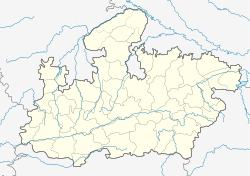Bhojpur is a town of historical and religious importance in Raisen District of Madhya Pradesh, India.
hojpur
Shiv Temple
| |||||||||||||||||
|---|---|---|---|---|---|---|---|---|---|---|---|---|---|---|---|---|---|

| |||||||||||||||||
| Coordinates: 23°6′54″N 77°35′43″E | Geography and hydrology
River Betwā at Bhojpur, showing remains of the southern dam
HistoryBhojpur takes its name from king Bhoja (reg. c. 1000–1055 CE), the most celebrated ruler of the Paramāra dynasty.[1] There is no archaeological evidence from Bhojpur before the eleventh century, a fact confirmed by local legends which recount how Bhoja made a vow to build a series of dams "to arrest the streams of nine rivers and ninety-nine rivulets". A location was found in the kingdom that allowed the king to fulfil this vow and the dams were duly built at Bhojpur.[2]Although the dams were constructed of cyclopean masonry, one of them was opened on the orders of Hoshang Shah of Malwa in the fifteenth century. According to Persian chronicles, he ordered the dam to be broken at the request of local merchants in Bhopal and Vidisha whose caravans were being raided by bandits taking refuge at an inaccessible spot protected by the lake.[3] Places of historical, archaeological and religious interestJain temples
Idols at the unfinished Jain Temple, Bhojpur
Main Temple & IdolThis huge temple was established in year 1100 AD. The miraculous idol of principal deity Bhagwan Shantinath in standing posture (22½ feet in height) is installed in the huge sanctum of this temple. On the both sides of this idol, 2 standing beautiful idols of Bhagwan Parshvanath & Suparshvanath (7th Teerthankar) 8 feet in height each are installed. Near the feet of Bhagwan Shantinath, artistic whisk bearers are carved on both sides.Bhojeśvar temple
The liṅga at the Bhojasvāmin temple, Bhojpur
The attribution of the temple to Bhoja is based on the testimony of Merutuṅga, who reports in the Prabandhacintāmaṇi that Bhoja bestowed on the poet Māgha "all the merit of the new Bhojasvāmin temple that he was about to build himself", and then "set out for the country of Mālava".[7] The style of the sculpture on the building confirms an early to mid-eleventh-century date for the structure. The building as it stands consists of the inner cella or garbhagṛha, supported by massive pillars, surmounted with an elegant corbelled dome. The outer walls and superstructure of the temple were never built. Quarries and rock drawings
Architectural fragments in one of the quarries at Bhojpur
Cave of PārvatīImmediately opposite the temple, on the west side of the gorge facing the Betwā, is a rock-shelter or cave, now occupied by religious mendicants. Popularly known as Pārvatī's Cave, the cave contains a number of sculptures and architectural fragments dating to the eleventh century.Remains of Bhoja's Royal Palace
One of the avenues in the ruins of the royal palace at Bhojpur
|







No comments:
Post a Comment